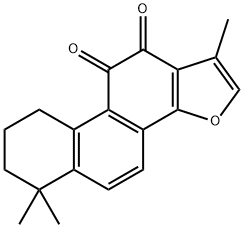Description
Tanshinone IIA mainly exists in the roots of Salvia miltiorrhiza Bge. Traditional
Chinese medicine Danshen, slightly cold and bitter, is often used for activating
blood circulation and eliminating stasis in Chinese medicine. It can also promote
blood circulation, open the energy channels, calm the heart, cool the blood, relieve
swelling, remove twinge in the heart and stomach, and remove carbuncle and erysipelas. It is classified as high grade in Shen Nong’s Herbal Classic. It has been used
as a traditional Chinese medicine in clinical practice for thousands of years. And it
is not only recorded in the leading medical works through the ages but also in CP
and USP.
Chemical Properties
Orange powder
Physical properties
Appearance: brick-red crystalline powder. Melting point: 209–210?°C. Solubility:
absorbs moisture easily, very soluble in hot water, slightly soluble in methanol or
ethanol, and practically insoluble in chloroform
History
The study of the chemical composition of Salvia miltiorrhiza began in the 1930s.
Japanese scholars first extracted three kinds of liposoluble components from
Danshen. They are tanshinones I, II, and III.
Uses
antineoplastic, bone resorption inhibitor, antiproliferative, apoptosis inducer
Definition
ChEBI: 1,6,6-trimethyl-8,9-dihydro-7H-naphtho[1,2-g]benzofuran-10,11-dione is an abietane diterpenoid.
Biochem/physiol Actions
Phenanthrenequinone constituent of Chinese medicinal herb Danshen (Salvia miltiorrhiza). Anti-inflammatory. Antioxidant. Cytotoxic against a variety of cell lines, inlcuding human glioma cells.
Pharmacology
Long-term researches show that tanshinone exhibits a variety of pharmacological
effects, such as the protection of the cardiovascular system, anti-infective effects,
and antioxidant effects.
As for the domestic pharmacological study of tanshinone IIA, it was first started
in the Shanghai Institute of Chinese Medicine. Professor Ding Guangsheng discussed the cardiovascular effects of tanshinone IIA.?He found that intraperitoneal
injection of tanshinone IIA sodium sulfonate (200?mg/kg) significantly prolonged
the survival time of mice under hypoxia atmosphere, and an increase in cardiac
output was observed in a dog under anesthesia with a one-time intravenous injection
of 20? mg/kg .
In recent years, the mechanism of tanshinone IIA is increasingly brought to further research. Tanshinone IIA can increase the activity of superoxide dismutase
(SOD) and interfere with the pathological process of many diseases, especially in
cardiovascular diseases. It can attenuate the damages from the reactive oxygen species to vascular endothelial cells, lower the risk of atherosclerosis, and reduce the
formation of atheromatous plaque.
tumor cells and the expression of various genes connected with the proliferation,
differentiation, and apoptosis of tumor cells. It may also have something to do with
the inhibition of telomerase activity in tumor cells, changes in antigen expression on
tumor cell surface, etc.
Clinical Use
Tanshinone IIA is a diterpenoid quinone liposoluble ingredient of high content, and
its chemical structure is the most representative in Danshen. In addition to tanshinone
IIA sodium sulfonate, there are a variety of preparations of Salvia common ketone
used clinically, such as tanshinone tablets, tanshinone capsules, tanshinone injection, Danshen Shuxin capsule, compound Danshen soft capsules, and compound
Danshen particles.
Cytotoxicity
IC50 (μg/mL): 0.59 (A549), 0.81 (TOV-21G) and 1.9 (MIAPaCa-2), NS (MV-3)(Chang et al. 2013; Fronza et al. 2011).
IC50 (μg/mL): 2.97 (HeLa), 2.71 (KB-3-1),>2.94 (NCI-H460), 2.62 (PC3), 2.94(MCF-7), 1.62 (K562)(Wu et al. 2014)
References
1) Kang et al. (2000), Inhibition of interleukin-12 and interferon-gamma production in immune cells by tanshinones from Salvia miltiorrhiza; Immunopharmacology, 49 355
2) Sung et al. (1999), Tanshinone IIA, an ingredient of Salvia miltiorrhiza BUNGE, induces apoptosis in human leukemia cell lines through the activation of caspase-3; Exp. Mol. Med., 31 174
3) Park et al. (1999), Suppression of AP-1 Activity by Tanshinone and Cancer Cell Growth Inhibition; Bull. Korean Chem. Soc., 20 925
